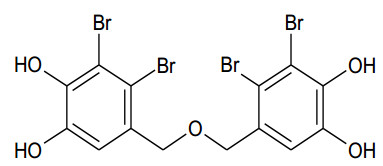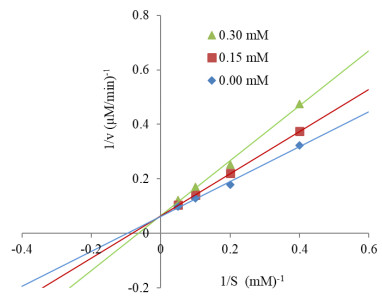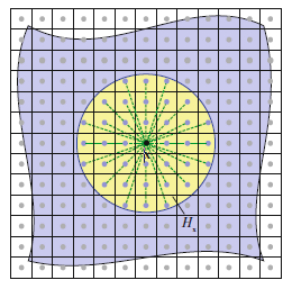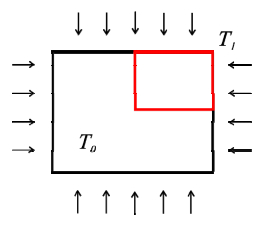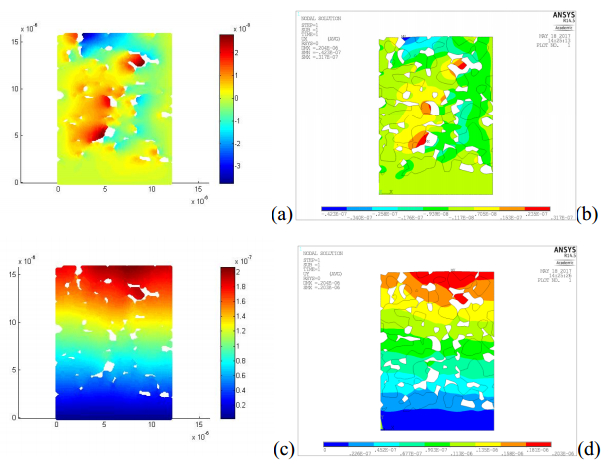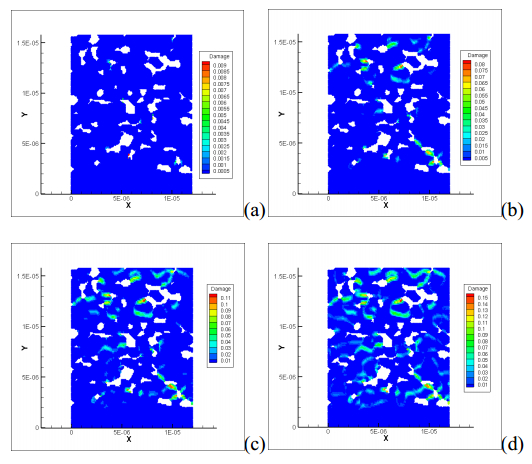Solid oxide fuel cell (SOFC) is widely used in hybrid marine propulsion systems due to its high power output, excellent emission control and wide fuel suitability. However, the operating temperature in SOFC will rise up to 800–1000 ℃ due to redox reaction among hydrogen and oxygen ions. This provides a suitable environment for ions transporting through ceramic materials. Under such operation temperatures, degradation may occur in the electrodes and electrolyte. As a result, unstable voltage, low capacity and cell failure may eventually occur. This study presents thermomechanical analysis of a porous SOFC cell plate which contains electrodes, electrolytes and pores. A microscale specimen in the shape of a plate is considered in order to maintain uniform temperature loading and increase the accuracy of estimation. A new computational technique, peridynamics, is utilized to calculate the deformations and stresses of the cell plate. Moreover, the crack formation and propagation are also obtained by using peridynamics. According to the numerical results, damage evolution depends on the electrolyte/electrode interface strength during the charging process. For weak interface strength case, damage emerges at the electrode/electrolyte interface. On the other hand, for stronger interface cases, damage emerges on pore boundaries especially with sharp corner.
1.
Introduction
The human gastrointestinal (GI) tract plays an important role in disease and health [1]. The GI tract has a dense microbial system that includes both aerobic and anaerobic microorganisms [2]. A study by Li et al. [3] suggested that gut microbiota composition is shaped by environmental factors, such as diet, and possibly also by host genetics. The gut microbiota provides benefits to the host by improving energy recovery from undigested food, defending the body against pathogens and interacting with both the immune and nervous systems to human metabolism by providing enzymes that are not encoded by the human genome [4]. Some of these enzymes include β-glucuronidase, β-glucosidase, β-galactosidase, nitroreductase, azoreductase, 7-α-dehydroxylase, and cholesterol dehydrogenase [5].
β-Glucuronidase (E.C.3.2.1.31) is widely distributed in plants, animals and bacteria. It is produced by some gastrointestinal bacteria, including Clostridia, Bacteroidacea, Eubacteria, Peptostreptococci and Bifidobacteria
[5]. It hydrolyses glucuronidated compounds, liberating glucuronic acid and the aglycone form that can be an imine, a thiol or an alcohol [6]. However, an increased activity of this enzyme is capable of retoxifying compounds that have been detoxified by liver glucuronidation, which is one of the most important detoxication processes in the liver [5]. It hydrolyzes glucuronide to liberate xenobiotics which exhibit toxicity in the intestine and decrease the excretion rate of xenobiotic via reabsorption [7]. The excessive expression of the enzyme has been implicated in a number of diseases including colon cancer [8], Crohn's disease [6], liver cancer and liver damage [9]. Bacterial β-glucuronidase inhibitors will promote excretion of xenobiotics and thus reducing the carcinogenic potential of toxic compounds [10]. Thus, finding novel β-glucuronidase inhibitors, especially from natural resources, would be of considerable importance.
Seaweeds are rich in pigment and polysaccharides, and have been known to possess antioxidative properties [11], antimicrobial activity [12] and anticancer activity [13]. A few reports are available for carbohydrase inhibitory activities, in which most researches focused on α-glucosidase [14], β-D-glucanase [15], and aldose reductase inhibitors [16]. Sekikawa et al. [7] reported that the methanol extracts of Chondria crassicaulis inhibited β-glucuronidase but could not identify the inhibitory compound. They found that the inhibitory components differed from each other due to the different inhibition mechanisms. In our previous study [5], β-glucuronidase inhibitors purified from Grateloupia elliptica were characterized.
The edible red alga G. lancifolia belonging to Halymeniaceae family, has been reported on antioxidant, tyrosinase and cholinesterase inhibitory activities in the previous study [17]. A bromophenol, bis (2, 3-dibromo-4, 5-dihydroxybenzyl) ether, was purified from G. lancifolia collected in the eastern coastal area of Korean peninsula. The isolated compound has been investigated for its α-glucosidase inhibitory activity in our previous study [18]. In the present study, the stability, kinetics and inhibitory activity of bis(2, 3-dibromo-4, 5-dihydroxybenzyl) ether isolated from G. lancifolia against β-glucuronidase were investigated.
2.
Materials and methods
2.1. Reagents
β-Glucuronidase and p-nitrophenyl-β-D-glucuronide (pNPG) were purchased from Sigma Chemical Co. (St. Louis, MO, USA). Sephadex LH-20 was purchased from Pharmacia Biotech Ltd. (Uppsala, Sweden). The other chemicals used in this study were of analytical grade.
2.2. Algal sample
G. lancifolia was harvested in the eastern coastal area of Korean peninsula in July and August 2017. For identification, the seaweed was fixed with 10% formalin-seawater (v/v) immediately after collected and transported to laboratory, then the sample was identified by microscope according to the method of De Clerck et al. [19]. Fresh alga was washed with tap water and air-dried in the shade at room temperature. Dried sample was cut into small pieces (2 × 3 cm), homogenized, sifted with a 500 μm sieve, and then stored at -40 ℃ until use.
2.3. Extraction and purification of β-glucuronidase inhibitor
β-Glucuronidase inhibitor was purified according to the method of Kim et al. [18]. The structures of β-glucuronidase inhibitor were identified by spectroscopic methods including 1H-NMR,
13C-NMR, and EI-MS. 1H and 13C-NMR spectra were recorded in methanol-d1 (MeOD) on a Bruker DRX-600 spectrometer (Bruker, Karlsruhe, Germany). Mass spectra were recorded on JEOL JMS-AX500 and JEOL JMS-SX102A spectrometers (Jeol, Tokyo, Japan).
2.4. Inhibitory assay of β-glucuronidase activity
β-Glucuronidase inhibitory activity was determined according to the method of Kim et al. [5]. 0.01 mL of 10 mM pNPG in 0.01 M phosphate buffer (pH 7) was premixed with 2.2 mL of sample solution and 0.01 mL of 20 U β-glucuronidase in the same buffer was added to the mixture to start the reaction. The reaction was carried out at 37 ℃ for 60 min and stopped by adding 1.5 mL of 0.1 M Na2CO3. Enzymatic activity was quantified by measuring the absorbance at 405 nm. One unit of β-glucuronidase activity was defined as the amount of enzyme liberating 1.0 μM of p-nitrophenol per min. One unit of β-glucuronidase inhibitory activity was defined as one unit decrease of β-glucuronidase activity. The IC50 value is defined as the inhibitor concentration to inhibit 50% of its activity under assayed conditions.
2.5. Stability of β-glucuronidase inhibitor
The stability of bromophenol at pH 2 and 37 ℃ was performed according to the method of Kim et al. [18]. Bromophenol was dissolved in a small amount of methanol and adjusted to a pH 2 with HCl, and then stood up at 37 ℃ for 0, 20, 40, and 60 min. The inhibitory activity of bromophenol against E. coli β-glucuronidase was determined as the mentioned above. The relative inhibitory activity of bromophenol at pH 2 was calculated based on the inhibitory activity of the control at pH 7.
2.6. Kinetics of β-glucuronidase inhibitor
The enzyme-inhibitor reaction was performed according to the mentioned above at 0.15 and 0.3 mM of inhibitor. The type of inhibition was determined using the Lineweaver-Burk plot [20], double reciprocal plot, of the substrate concentration and velocity. The inhibition constant (KI value) was determined by Dixon plot analysis.
2.7. Statistical analysis
Statistical analysis of the data was carried out by Duncan's multiple comparison test (p < 0.05) using the SPSS software package version 11.0 program from SPSS Inc. (Chicago, IL, USA).
3.
Results and discussion
3.1. Extraction and purification of β-glucuronidase inhibitor
The inhibitory activity of aqueous MeOH extract of G. lancifolia against β-glucuronidase was 28.4% at 5 mg mL-1
[5], 80% MeOH was the best extractive solvent in terms of β-glucuronidase inhibitory activity, followed by 80% Me2CO and 100% MeOH in order (data not shown). Therefore, 80% MeOH was used to extract β-glucuronidase inhibitor from G. lancifolia in the present study. The MeOH extraction was concentrated in vacuum and successively partitioned with n-hexane, CHCl3, EtOAc and n-BuOH. In the consecutive solvent fractionations of inhibitors,
β-glucuronidase inhibitory activities of the EtOAc fraction at concentrations of 0.1, 1, and 4 mg mL-1 were 22.3%, 42.4%, and 55.4%, respectively, whereas those of BuOH fraction were 13.4%, 13.4%, and 15.5% (Table 1). However, no β-glucuronidase inhibitory activities were observed in the n-hexane, CHCl3 and water fractions. Lipids, chlorophyll, refined oil and sterol are dissolved and fractionated in n-hexane, and resin is usually extracted with CHCl3. In addition, polyphenols such as flavonoid and tannin are extracted in EtOAc, and water-soluble components are shifted over in BuOH [21]. The present study found that a large amount of solute in 80% MeOH extract was shifted over to n-hexane (62.2%) and CHCl3 (12.1%), but neither had any β-glucuronidase inhibitory activity at up to 4 mg mL-1 (Table 1). The results suggested that phenolic compounds could be responsible for β-glucuronidase activity of G. lancifolia.
The active compound was purified according to our published procedures [18]. The structure of β-glucuronidase inhibitor from G. lancifolia was identified as bis(2, 3-dibromo-4, 5-dihydroxybenzyl) ether, a bromophenol (Figure 1), according to spectral data [18]. The structure of β-glucuronidase inhibitor, bis(2, 3-dibromo-4, 5-dihydroxybenzyl) ether, purified from G. lancifolia was different from 2, 4, 6-tribromophenol and 2, 4-dibromophenol purified from G. elliptica (Halymeniaceae) in the previous study [5] but was the same as bromophenol from G. lancifolia [18] and Rhodomela confervoides [22]. β-Glucuronidase inhibitors are categorized as terpenoids and their glucuronides, flavonoids and their glucuronides, and pseudo-sugar containing nitrogen [23], in which bromophenols are classified into phenolic compounds.
Bis(2, 3-dibromo-4, 5-dihydroxybenzyl) ether. EI-MS (positive) m/z 581 (17), 579 (67), 577 [M]+ (100), 575 (71), 573 (19), 1H NMR (600 MHz, MeOD) δH 7.14 (2H, s, H-6, 6'), 4.59 (4H, s, H-7, 7'), 13C NMR (150 MHz, MeOD) δC 131.3 (C-1, 1'), 114.7 (C-2, 2'), 113.8 (C-3, 3'), 144.7 (C-4, 4'), 145.6 (C-5, 5'), 115.6 (C-6, 6'), 73.2 (C-7, 7').
3.2. Inhibitory activity of bromophenol against β-glucuronidase
IC50 and KI (inhibition constant) values of the G. lancifolia bromophenol against E. coli β-glucuronidase were 0.54 and 0.53 mM, respectively (Table 2), which is much more effective than 2, 4, 6-tribromophenol (5.4 mM of IC50) and 2, 4-dibromophenol (8.5 mM of IC50) purified from G. elliptica [5]. The G. lancifolia bromophenol inhibited β-glucuronidase competitively (Figure 2, Table 2).
Polyphenolic compounds from terrestrial plants are typically derived from gallic and ellagic acid, while phenolics from marine macroalgae range from basic molecules such as phenolic acids to highly complex phlorotannin (PHT) compounds [24] thus might result in exerting inhibitory activity. For example, o-quinones derived from catechols are covalently bound to protein amino acid and thiol groups [25]. Algal β-glucuronidase inhibitor, bromophenol, belongs to phenolic compounds could bind to both active and non-active site of the enzymes [26,27]. These results suggested that bromophenol of red alga, G. lancifolia is an effective inhibitor against β-glucuronidase.
Endo-β-D-glucuronidase (commonly referred to as heparanase) is an extracelluar matrix enzyme that degrades heparin sulfate and heparin sulfate proteoglycans, the major components of extracelluar matrix and basement membrane [28]. Therefore, this enzyme is thought to accelerate cancer invasion and metastasis, and is expressed to a higher extent during inflammation, angiogenesis or malignant transformation [29]. Oral administration of Lentinus edodes significantly inhibited mouse fecal β-glucuronidase and tryptophanase [30]. Gudiel-Urbano and Goni [31] also reported that the intestinal β-glucuronidase activity in rats decreased when seaweeds (Undaria pinnatifida and Porphyra ternera) were fed. Crude drug containing β-glucuronidase inhibitor decreased toxic side effects of the metabolite SN-38 of the anticancer agent CPT-11 [32]. Guo et al. [33] mentioned that soybean saponins were effective in inhibiting colon cancer in rats by downregulating the activity of β-glucuronidase in colonic mucosa but not the COX-2 protein expression and PGE2 level. Hence, bromophenol purified from G. lancifolia, a potent β-glucuronidase inhibitor, can be used as a novel pharmaceutical agent for the prevention and treatment of colon cancer.
3.3. Stability of bromophenol against β-glucuronidase
The acidic condition (pH 2) was used to mimic the pH encountered by bromophenol in the stomach. The inhibitory activity of bromophenol against E. coli β-glucuronidase was very stable at pH 2 and remained approximately 96, 94 and 78% for 20, 40 and 60 min, respectively (Figure 3). This result suggested that the bromophenol purified from G. lancifolia was very stable under acidic condition and can be a candidate for development of a β-glucuronidase inhibitor.
4.
Conclusions
In this study, bis(2, 3-dibromo-4, 5-dihydroxybenzyl) ether with a strong β-glucuronidase inhibitory effect was purified from macroalga G. lancifolia. The isolated compound showed the good effect on β-glucuronidase and was very stable in acidic condition. It is suggested that this bromophenol could be developed as a novel natural pharmaceutical agent. However, the result was just obtained in vitro, therefore further study should be carried out in vivo for commercial application.
Acknowledgements
This study was in part financially supported by the Project of Khanh Hoa Province (No. ĐT-2017-20902-ĐL to Dr. The Han Nguyen), Vietnam.
Conflict of interest
The authors declare no conflict of interest.









 DownLoad:
DownLoad:
